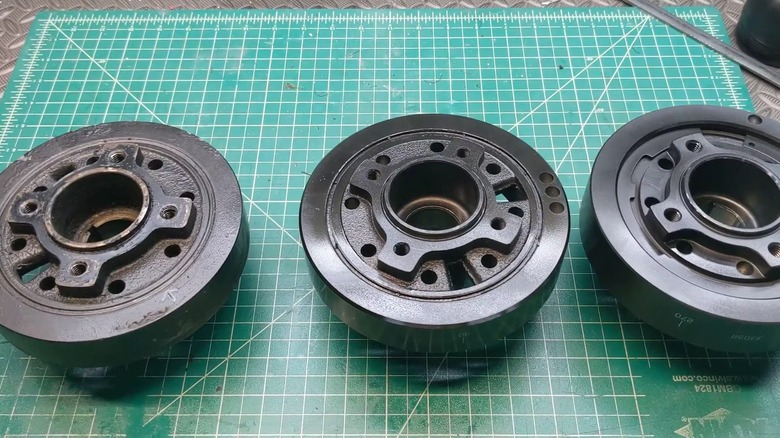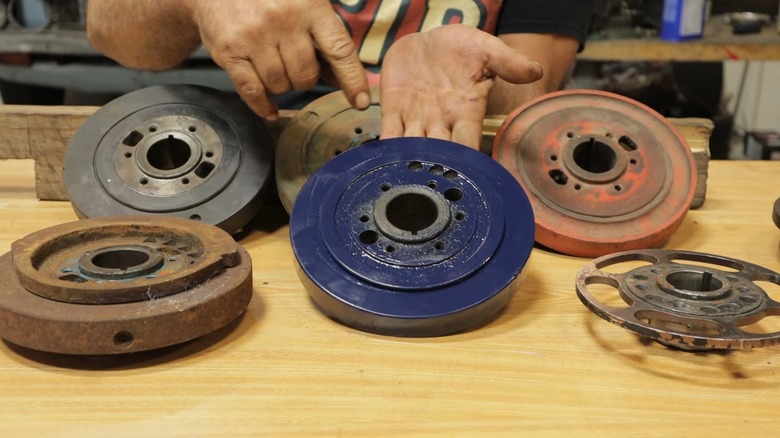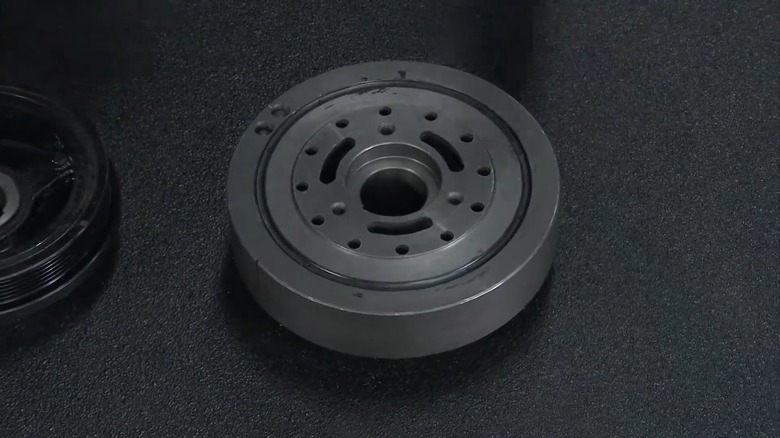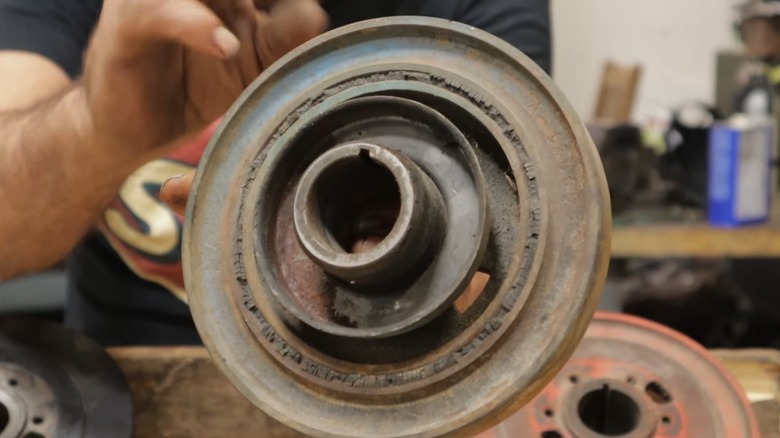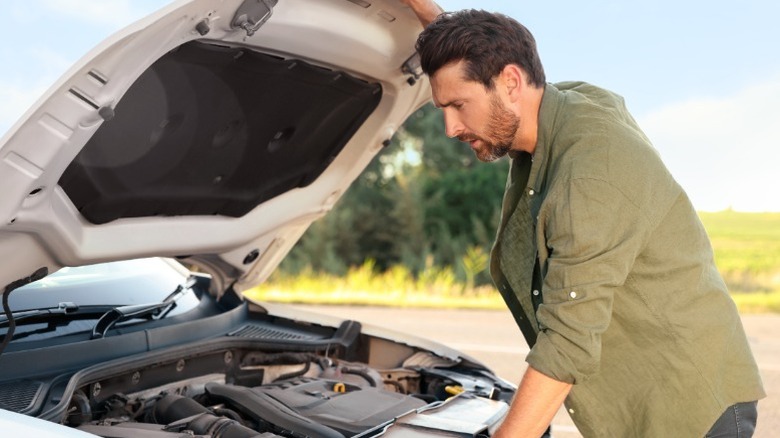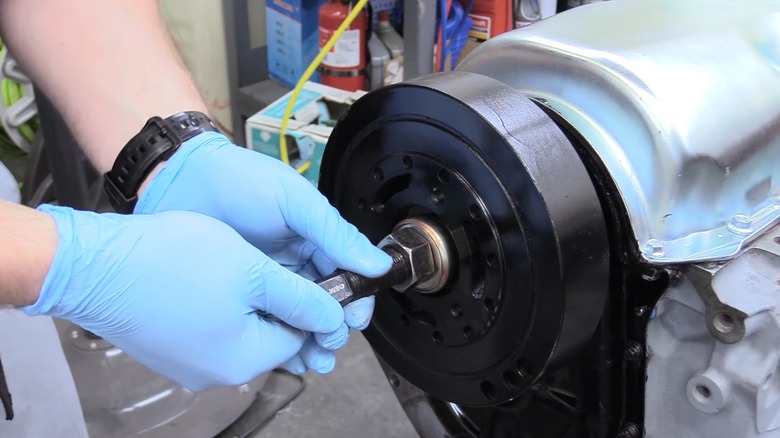What Does An Engine's Harmonic Balancer Do? (And Signs It's Gone Bad)
The internal combustion engines that power our cars rely on an extensive series of interconnected parts, mechanical systems, and electronics to send us down the road. Some of those components are well-known, like the pistons, serpentine belt, and engine control module (ECM). However, other parts are less well-known, despite being incredibly important to your vehicle's smooth operation. One such part is the harmonic balancer.
The harmonic balancer — also known as the harmonic dampener or crankshaft dampener — is responsible for stabilizing your engine's crankshaft by absorbing shocks and vibration caused by the shaft's torsional twisting movement. That movement is an unintended consequence of the internal combustion process. While the crankshaft is supposed to spin as a result of the combustion process, it's not supposed to twist. Torsional twisting can cause fractures and other damage to the crankshaft, in addition to creating excessive shaking and vibrations as you drive. The harmonic balancer addresses this issue by stabilizing the crankshaft.
Harmonic balancers are incredibly durable components. However, they are subject to wear and tear over time, and if yours goes bad, it can result in some seriously annoying symptoms. For that reason, it's a good idea to keep an eye out for any signs of harmonic balancer trouble. Doing so can help you stay ahead of severe issues and address potential malfunctions before they become more serious and expensive. Fortunately, we'll break it all down for you. As a former professional mechanic and lifelong car nut, I'll explain everything you need to know about your engine's harmonic balancer, including how it works, signs that it's gone bad, and how much it costs to replace. Let's dive in.
Why are harmonic balancers necessary?
Before you can understand why your engine needs a harmonic balancer, it will probably be helpful to explain briefly how the internal combustion process works. Your engine sucks in oxygen through the air intake system, while the fuel system sends the engine gasoline or diesel. The oxygen and fuel mix in combustion chambers, before your spark plugs cause the mixture to ignite. The resulting small explosions propel the engine's pistons up and down, which, in turn, causes the crankshaft to spin and send power to various parts of the car. However, those explosions can also be pretty jarring to the crankshaft and cause it to twist slightly. That torsional twisting can cause premature damage to the crankshaft while also contributing to an unpleasant driving experience.
The harmonic balancer is designed to combat that problem by absorbing the shocks that cause the shaft to twist. Without the harmonic balancer, not only would your crankshaft last for significantly less time, but you would also be subjected to intense vibrations while driving.
How does an engine's harmonic balancer work?
Now that you know why the harmonic balancer is necessary, let's explore how it works. As mentioned, the harmonic balancer's job is to absorb vibrations and stabilize the crankshaft. It's able to achieve this feat thanks to its simple yet ingenious design. While the construction and materials used can vary based on the engine type and application, most standard harmonic balancers are made up of a center hub, a thick rubber dampener, and a heavy outer balancing ring.
The harmonic balancer connects to the front of the crankshaft. Depending on the vehicle, it may bolt to the crankshaft pulley or the two components may be built together as a single unit. The center hub connects to the crankshaft, transferring the shaft's rotational power and torsional twisting movement to the balancer, while the thick rubber dampener absorbs shocks and vibrations. The outer ring transfers the crankshaft's power to the pulley, which relies on a serpentine belt to drive various other engine accessories, like the air conditioning compressor, alternator, and power steering pump. The core responsibility of the harmonic balancer is to stabilize the crankshaft and absorb shocks, but some harmonic balancers have secondary functions, including using offset weights to help balance the crankshaft and related components.
What are the signs of a bad harmonic balancer?
Harmonic balancers are intensely durable components by necessity. However, that doesn't mean that they're immune to wear and tear over time. Generally, there is no set replacement or service interval for the harmonic balancer, but many automotive experts recommend getting the balancer inspected as part of your routine maintenance plan. That usually involves visually checking the harmonic balancer for cracks and other physical damage, or using a device called a durometer to gauge the rubber dampener's condition.
Outside regular inspections, you'll also want to keep an eye out for any signs of harmonic balancer failure. The symptoms of a bad harmonic balancer can vary, but some of the most common issues you may experience include intense engine vibration, visual harmonic balancer or crankshaft pulley wobble, rattling noises from the engine bay, a lit check engine light, and visible damage. You may also experience issues with your serpentine belt and the accessories that it powers. All that said, remember that most of those problems can be the result of other malfunctions. So, if you experience any of them yourself, you should visit a professional auto repair technician as soon as possible.
Can you drive with a bad harmonic balancer?
If you experience any of the symptoms of a bad harmonic balancer, you might be curious if it's okay to keep driving your car until you can visit a repair shop. The answer is mostly a resounding no. You should avoid driving with a bad harmonic balancer whenever possible. Driving with a worn-out or broken harmonic balancer will not only expose you to things like a shaky, unstable ride, which is dangerous on its own, but it can also lead to extreme engine damage.
Remember that the harmonic balancer's job is to absorb shocks and vibrations to keep the crankshaft stable. If it fails to perform that function, your crankshaft will become increasingly unstable. That can lead to things like serpentine belt damage, engine accessory malfunctions, and internal engine damage. While replacing your serpentine belt may not seem like a huge expense, replacing damaged pulleys and accessories like the power steering pump, air conditioning compressor, and alternator can come with steeper price tags. But all of that pales in comparison to the real problems that you're likely to experience if you drive with a bad harmonic balancer. As the crankshaft rattles around more and more, it's likely to develop stress cracks and fractures. It may also begin causing damage to things like the main bearings and pistons. If your crankshaft breaks or develops fractures, or if you develop severe damage to other internal components like the pistons and bearings, you'll likely be forced to pay for an engine rebuild or replace it altogether. Both of those options are costly, so you should prioritize replacing a faulty harmonic balancer as soon as possible to avoid unnecessary expenses.
How much does it cost to replace a harmonic balancer and can you do it yourself?
Considering the urgency with which you should replace a bad harmonic balancer, you might be wondering if it's an expensive part to replace and whether you can do it yourself. Exact replacement prices will depend on things like your location, your car's make and model, and your vehicle's age. However, on average, the service should cost between $350 and $600. Replacement parts can range in price from around $50 for budget versions to upwards of $200 for performance parts. The mechanic's labor, on the other hand, will vary based on the shop you visit, but you should expect it to cost around $100 to $300.
While that's not the most expensive automotive repair job, it's also not the cheapest. If you'd like to save some cash, you may be curious about whether a DIY replacement is possible. First, yes, it is possible to DIY your harmonic balancer replacement. However, it's also worth noting that replacing a harmonic balancer is a bit more complicated than some of the best DIY auto projects. While replacing it should be relatively simple for home mechanics and experienced DIYers, novices may struggle. That said, even if you're a complete car novice, you can complete a harmonic balancer replacement with the right know-how. Just remember to triple check that you have the proper tools, adequate space to work, and enough time to allow yourself to move at a comfortable pace — also, don't forget to invest in a vehicle-specific repair manual to help guide you through the process.
